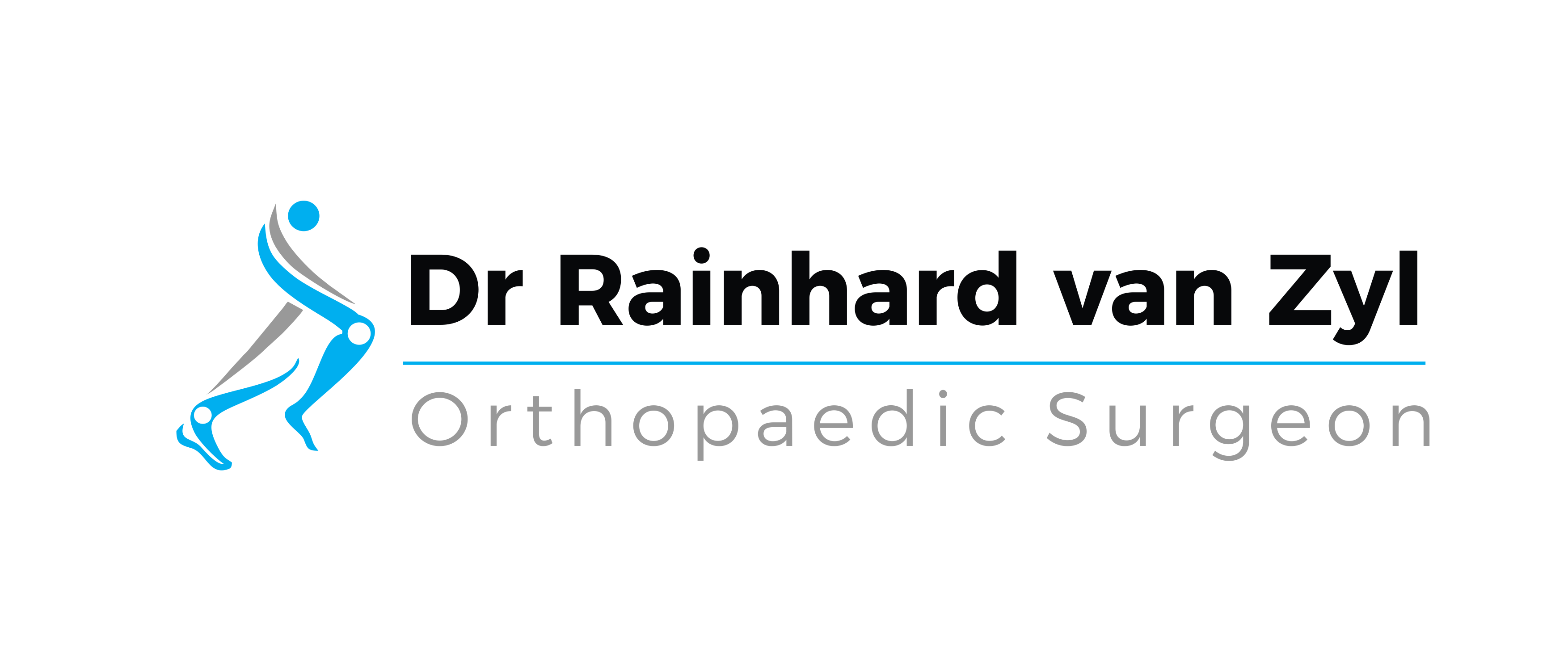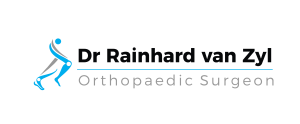A CAPE TOWN-BASED ORTHOPAEDIC SURGEON
Dr. Rainhard van Zyl is an AOA fellowship trained and recognised surgeon specialising in orthopaedic trauma and adult hip and knee surgery.
Knee Conditions
Knee Arthritis
Knee arthritis can make it hard to do many everyday activities, such as walking or climbing stairs. It is a major cause of lost work time and a serious disability for many people. The most common types of arthritis are osteoarthritis and rheumatoid arthritis, but there are more than 100 different forms. While arthritis is mainly an adult disease, some forms affect children. Although there is no cure for arthritis, there are many treatment options available to help manage pain and keep people staying active.
As with other arthritic conditions, initial treatment of the knee is quite often nonsurgical. Treatment options may include lifestyle modifications, physiotherapy, medications, alternative therapies and assistive devices. However, once these treatments have been exhausted, your doctor may suggest knee arthritis surgery.
Before any surgical treatment is undertaken, Dr van Zyl will thoroughly discuss the risks and possible complications associated with arthritis surgery and whether it is the correct option for you.
Meniscal Tears
There are two menisci in each knee – medial (inside) and lateral (outside). They are a very special type of cartilage, and act like shock absorbers within the knee to reduce pressure and stress across the joint.
The medial meniscus is on the inside of the knee, it is attached to the ligaments on the inside of the knee (MCL) and the joint capsule. As it is more firmly attached to the deep structures of the knee, it is more commonly injured than the lateral meniscus. It takes approximately 50% of the weight across the medial (inside) compartment of the knee. The lateral meniscus is on the outside of the knee, it is more mobile and ‘C’ shaped than the medial meniscus. It takes up to 80% of the weight across the outside compartment of the knee.
In cross section the meniscus looks like a triangle – with the apex (tip) on the inside and the base on the outside. The two parts of the meniscus like a ‘bow tie’
Discoid Meniscus
A discoid meniscus is an abnormally formed meniscus (shock absorber) in the knee.
Patellofemoral Arthritis
Patellofemoral arthritis affects your kneecap (patella bone). It causes pain in the front of your knee and can make it difficult to kneel and climb stairs.
Anterioir Cruciate Ligament Injury ( ACL)
One of the most common knee injuries is an anterior cruciate ligament sprain or tear. Athletes who participate in high demand sports like soccer, rugby, and basketball are more likely to injure their anterior cruciate ligaments. If you have injured your anterior cruciate ligament, you may require surgery to regain full function of your knee. This will depend on several factors, such as the severity of your injury and your activity level.
Patellar dislocation & instability (Unstable Kneecap)
Your kneecap (patella) is usually resting in a groove at the end of the thighbone (femur). When the knee bends and straightens, the patella moves straight up and down within the groove, similarly to a train running on a track. Sometimes, the patella slides too far to one side or the other. When this occurs, the patella can completely or partially dislocate.
Painful Total Knee Replacement
Total knee replacement is an effective operation at relieving pain and restoring function. In some cases problems can arise after undergoing knee replacement which can result in pain and stiffness. This can be due to a wide variety of reasons, and it needs very careful examination and investigation to establish its underlying cause.
Pain after knee surgery can be due to a wide variety of reasons. It can be generated from within the knee joint, outside the knee, or referred from problems in the hip or spine.
Osgood Schlatters Disease
Osgood Schlatters disease is an inflammatory condition which affects the insertion of the patella tendon into the tibia (shin bone).
Osteochondral Defects (OCDS)
Osteochondral defects of the knee are a common source of knee pain, swelling and discomfort in children, adolescents and young adults. Osteochondral defects (OCDs) are diseased areas of bone (“osteo”) and cartilage (“chondral”). There are two main types of Osteochondral defects. Traumatic, which are normally as a result of patella dislocation or injury to the knee joint and Osteochondritis Dissecans, which occurs typically without a history of trauma and may affect both left and right knees.
PLICA
Plica are bands of tough fibrous tissue which are found within the knee joint. Then can be an important source of pain within the knee as they can rub, become trapped or inflamed.
Plica can be very difficult to diagnose, as they do not show up on X Rays and can be difficult to see on MRI. Often they are only diagnosed by arthroscopic evaluation o the joint (keyhole surgery).
Knee Treatments
Total Knee Replacement
If your knee is severely damaged by arthritis or injury, it may be hard for you to perform simple activities, such as walking or climbing stairs. You may even begin to feel pain while you are sitting or lying down. Damage caused by knee arthritis can lead to severe discomfort, impairing your overall quality of life. If nonsurgical treatments like medications and using walking supports are no longer helpful, you may want to consider total knee replacement surgery.
Computer Assisted Knee Replacement
Computer-assisted total knee replacement is a procedure that utilizes sophisticated computer imaging to assure the highest level of precision during the knee replacement procedure. With the aid of a real time infrared based tracking system, we can achieve virtually perfect alignment and soft tissue balance, which are the two most critical components of a successful knee replacement.
Robotic Knee Replacement
Robotic knee replacement, either partial or total, involves the use of computer-controlled instruments to precisely make cuts in the femur and tibia bone to allow for highly accurate component placement. The surgeon does all aspects of the surgery such as skin incision, stopping bleeding, exposing the knee joint, cutting the bones, placing the implants closing the wounds etc, and the robot is used for assistance during bone cuts and implant positioning.
Partial Knee Replacement
During knee replacement surgery, damaged bone and cartilage is resurfaced with metal and plastic components . Unicompartmental knee replacement (also called “partial” knee replacement) differs in that only a section of the knee is resurfaced. This procedure can be a viable alternative to total knee replacement in cases where the disease is limited to a portion of the knee.
Because a partial knee replacement is a more limited procedure, patients spend less time in the hospital and return to normal activities quicker than total knee replacement patients.
Revision Knee Replacement
A knee revision is the replacement of prosthetic implants in a person who previously had a total knee replacement. In this surgery, known as a “reoperation,” an original prosthesis is removed and a new prosthesis put in place.
Some knee revisions may require the replacement of only one implant, while others require a complete exchange of all the prostheses that were implanted during the original knee replacement surgery . A complete revision of this type is a complex procedure that requires extensive preoperative planning, specialized implants and tools, prolonged operating times, and mastery of difficult surgical techniques.
Knee Arthroscopy
Knee arthroscopy is a surgical procedure that allows Dr. van Zyl to inspect the knee joint and make a diagnosis without the use of large incisions through skin and soft tissue. During arthroscopy, a small camera referred to as an arthroscope is inserted into the joint which then feeds an image to a video monitor. Dr. van Zyl then uses this video feed to guide miniature surgical instruments to perform the procedure.
As these instruments and the arthroscope itself are very small, only a very small incision is required compared to that required for open surgery. The use of a smaller incision means that recovery may be faster as less skin and tissue is damaged as part of the surgery, resulting in reduced pain and joint stiffness.
Knee arthroscopy may be recommended if you have a painful condition that is not responding to more conservative forms of treatment such as rest, physiotherapy or anti-inflammatory medication.
ACL Reconstruction / Knee Reconstruction
ACL reconstruction surgery involves taking a tendon graft from one part of your body and inserting it into your knee to function as an ACL.
ACL reconstruction surgery involves taking a tendon graft from one part of your body and inserting it into your knee to function as an ACL.
Patella stabilisation is a broad term to describe surgery that is used to stabilise (prevent dislocation) of the kneecap (patella). There are many options for this type of surgery, which can include both bone and soft tissue procedures or a combination of both.
Knee Osteotomy
Osteotomy literally means “cutting of the bone.” In a knee osteotomy, either the tibia (shinbone) or femur (thighbone) is cut and then reshaped to relieve pressure on the knee joint.
Knee osteotomy is used when a patient has early-stage osteoarthritis that has damaged just one side of the knee joint. By shifting weight off of the damaged side of the joint, an osteotomy can relieve pain and significantly improve function in an arthritic knee.

